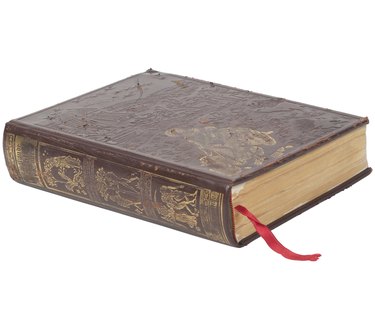Things You'll Need
Isopropyl alcohol
Acetone or nail polish remover
Cotton balls
Leather conditioner
Rag

The gold lettering found on leather-bound books and leather items is usually made from gold foil or gold leaf that has been attached to the surface of the leather using an adhesive. Some items are foiled and embossed using a combination of heat and pressure. Removing the gold lettering from leather is a function of removing the adhesive that holds the lettering in place, preferably without damaging the leather. Since adhesives are organic or inorganic chemicals, a chemical solvent will remove it from any surface, including leather. Suitable solvents are isopropyl alcohol and acetone or nail polish remover, which can be readily obtained from a drugstore or supermarket.
Isopropyl Alcohol
Step 1
Moisten the cotton ball with isopropyl alcohol.
Video of the Day
Step 2
Rub the alcohol-moistened cotton ball over the gold lettering until it completely dissolves from the leather's surface. Use gentle but firm pressure and rub vigorously to remove the gilding. You may need to re-moisten the cotton ball occasionally. Use additional cotton balls if the lettering is extensive.
Step 3
Clean all traces of alcohol from the leather with a damp rag or cotton ball.
Step 4
Condition the leather by rubbing it with a leather conditioner, as alcohol evaporates quickly, stripping the moisture from the leather as it evaporates.
Acetone
Step 1
Moisten the cotton ball with acetone or nail polish remover, which contains a mixture of acetone and moisturizing ingredients.
Step 2
Rub the moistened cotton ball over the gold lettering until it completely dissolves from the leather's surface. Use gentle pressure and a gentle rubbing motion to remove the gilding, as acetone is a powerful solvent and will leach any dyes out of the leather. You may need to re-moisten the cotton ball occasionally. Use additional cotton balls if the lettering is extensive.
Step 3
Clean all traces of acetone or nail polish remover from the leather with a damp rag or cotton ball.
Step 4
Condition the leather by rubbing it with a leather conditioner, as acetone may cause dryness.
Tip
Test the acetone or nail polish remover on a portion of the leather that is not visible during normal use. Watch for adverse reactions and stripping of the dye. Do not use the acetone method if the results are not to your liking.
The solvent will remove the gold lettering from the surface of the leather, but if it has been stamped or embossed, the depressed lettering may still be visible on the surface.
Video of the Day
- The Gold Vault : Gold Leaf Techniques Applied to Leather
- Museum of Fine Arts, Houston; The Use of Aquazol-Based Gilding Preparations; Chris Shelton
- BuildingConservation.com: Gilding; Kevin Howell; 1999
- TechLib.com: Paint and Adhesive Removal
- Painting and Decorating on the Net: Gilding and Gold Leaf
- Antique Restorers: Shellac – A Traditional Finish Still Yields Superb Results” Jeff Jewitt